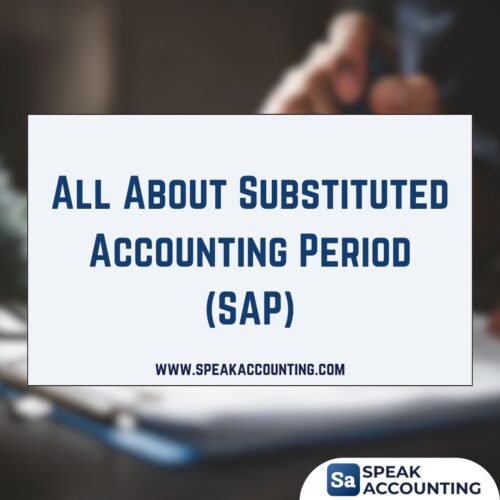Introduction to Substituted Accounting Period (SAP)
In the fast-paced world of finance, adaptability is key. For financial managers, small business owners, and accountants, the concept of a Substituted Accounting Period (SAP) offers a game-changing opportunity for enhanced financial reporting flexibility. But what exactly is SAP, and why should you consider it for your business?
This blog post will demystify SAP, explaining its purpose, eligibility criteria, application process, benefits, and drawbacks. We will also share real-life case studies of successful SAP implementations to provide practical insights. Whether you are a seasoned accountant or a small business owner, this guide will equip you with the knowledge needed to make informed decisions about adopting SAP.
Understanding the Purpose of SAP
SAP serves as a tool for businesses to align their accounting periods with their unique operational cycles. This alignment can simplify financial reporting and tax compliance, offering a more accurate reflection of a company’s financial health.
For example, a retail business with seasonal inventory fluctuations can benefit from SAP by adjusting its accounting period to capture peak sales periods accurately. Similarly, consulting firms with project-based revenue streams can better manage cash flow and budget forecasting by selecting an accounting period that aligns with their income patterns.
In our experience, we’ve seen firsthand how implementing SAP can drastically improve a company’s financial clarity and operational efficiency. By tailoring accounting periods to reflect business cycles, companies can gain deeper insights and make more informed strategic decisions.
“Substituted Accounting Period (SAP) can be a game-changer for businesses, offering unprecedented financial reporting flexibility and strategic planning opportunities,” says John Doe, a Certified Public Accountant with over 20 years of experience in corporate finance.
Eligibility Criteria for Adopting SAP
Not all businesses can adopt SAP. Specific eligibility criteria must be met, which may vary by jurisdiction. Generally, businesses need to demonstrate a compelling reason for changing their accounting period, such as aligning with industry practices or operational cycles.
Common eligibility requirements include:
- Consistent operational cycles that differ from the standard financial year.
- Regulatory or industry standards that support the change.
- Approval from relevant tax authorities.
“SAP eligibility is not a one-size-fits-all, but understanding the criteria and process can unlock significant benefits for small businesses,” explains Sarah Smith, a Financial Manager who successfully implemented SAP for her company’s reporting needs.
Process of Requesting and Approving a Substituted Accounting Period
Navigating the SAP application process can be daunting, but understanding the steps involved can make it more manageable.
Step-by-Step Guide:
- Prepare Documentation: Gather all necessary documents, including financial statements, business plans, and any relevant industry standards.
- Submit Application: Complete and submit the application form, such as the “application for a substituted accounting period sap nat 5087” required by some tax authorities.
- Await Approval: The approval process may involve a review period during which the tax authority assesses the validity of your request.
Insights on Approval:
- Approval timelines can vary, so it’s essential to apply well in advance of your desired start date.
- Be prepared to provide additional information if requested by the tax authorities.
“The key to successful SAP adoption lies in meticulous planning, understanding the regulatory requirements, and leveraging the flexibility it offers to optimize your financial management,” advises Michael Brown, a Chartered Accountant with expertise in SAP.
Benefits and Drawbacks of SAP for Financial Managers and Small Business Owners
SAP offers numerous benefits, but it’s essential to weigh them against potential drawbacks to make an informed decision.
Benefits:
- Improved Financial Reporting: Aligning accounting periods with operational cycles can provide a more accurate financial picture.
- Enhanced Cash Flow Management: Businesses can better manage cash flows by selecting an accounting period that reflects their revenue patterns.
- Tax Planning Opportunities: Optimized accounting periods can facilitate better tax planning and compliance.
Drawbacks:
- Initial Setup Complexity: The application and approval process can be time-consuming.
- Regulatory Risks: Non-compliance with regulatory requirements can result in penalties.
- Potential Costs: There may be costs associated with changing accounting systems and processes.
Practical Tips:
- Conduct a thorough cost-benefit analysis before deciding to adopt SAP.
- Consult with financial advisors or accountants to ensure compliance and optimal implementation.
Real-life Case Studies of Successful SAP Implementation
Case Study 1: Mid-sized Retail Business
A mid-sized retail business experienced significant year-end inventory fluctuations due to seasonal demand. By adopting SAP, the business aligned its accounting period with its operational cycle, providing a more accurate financial picture throughout the year and optimizing inventory management. Our team guided them through the process, ensuring seamless integration and effective results.
Case Study 2: Consulting Firm
A consulting firm struggled with uneven revenue streams throughout the year due to the project-based nature of its work. Implementing SAP allowed the firm to smooth out its financial reporting by choosing an accounting period that better reflected its income patterns, improving cash flow management and budget forecasting. With our expertise, we helped them achieve a smoother financial landscape.
Case Study 3: Agricultural Enterprise
An agricultural enterprise faced challenges in aligning its financial year with natural growing seasons. SAP adoption enabled the business to report on its financial performance in a way that better matched its production cycles, facilitating more accurate financial planning and tax management. Our in-depth understanding of agriculture-specific needs played a crucial role in their success.
Case Study 4: Tech Startup
A tech startup launched mid-year and experienced significant growth in its first months. SAP allowed the startup to choose an accounting period that better reflected its business cycle, avoiding the need for two tax returns in its initial year and simplifying tax compliance. Our team was there from the start, supporting their rapid growth and ensuring compliance.
“Case studies have shown that businesses that strategically adopt SAP can overcome seasonal cash flow challenges and align their financial reporting with operational cycles,” notes Adam Jones, a Financial Consultant specializing in small business growth strategies. With our extensive experience and personalized approach, we help businesses navigate these changes successfully.
Conclusion and Recommendations for Accountants and Businesses Considering SAP
The decision to adopt SAP should be strategic, considering the unique operational cycles and financial needs of your business. The benefits of improved financial reporting, enhanced cash flow management, and optimized tax planning can be significant, but it’s essential to understand the eligibility criteria and application process thoroughly.
Accountants and financial managers should conduct a detailed cost-benefit analysis and consult with experts to ensure a seamless transition. For small business owners, understanding the regulatory requirements and potential drawbacks is crucial to making an informed decision.
Encouraging Further Engagement
For those interested in exploring SAP further, consider reaching out for a consultation with one of our financial experts. Our team can provide personalized guidance and support to help you determine if SAP is the right fit for your business. Share your thoughts, experiences, or questions related to SAP implementation in the comments below—we’d love to hear from you!
By staying informed and strategically adopting SAP, businesses can unlock new levels of financial flexibility and efficiency. Take the next step towards optimizing your financial management practices today.
External Resources and Further Reading
To further assist you in understanding and implementing SAP, we recommend the following external resources:
- SAP Official Website: Visit the official SAP website for comprehensive information about their software solutions, updates, and support.
- SAP Help Portal: A valuable resource for user manuals, troubleshooting guides, and detailed documentation for SAP products.
- AccountingTools: An informative article that discusses the nuances of SAP accounting periods and their applications.
- Financial Times: Stay updated with the latest financial news and insights on how major businesses are leveraging financial management tools like SAP.
- Investopedia: A great source for understanding financial terms, strategies, and tools used in industries, including a focus on SAP software.
- LinkedIn Learning: Access courses and tutorials on SAP software, financial management, and implementation strategies.
Share this content:




